Toilet Found! is sustained by readers who made purchases through specific links on this site. Learn more
Siphonic vs Washdown Toilet. Which Is Better?
Siphonic vs Washdown Toilet – A Comparison
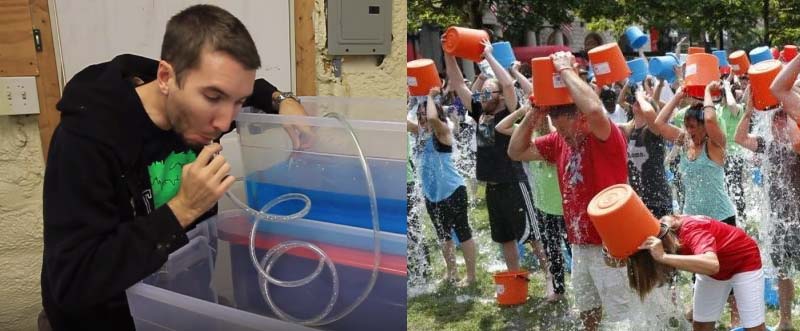
Siphonic vs Washdown Toilet. The Pros & Cons
When you are not familiar with how a toilet works, it is fair that you think all toilets flush the same way. But the fact is, they don’t. Not to the Americans and Europeans at least, and they don’t see eye to eye in the way a toilet flushes.
Though toilet flushing is no rocket science, it has seen some major changes in recent years. Changes that allow toilets to use a lot less water and at a higher efficiency in disposing of waste.
But one thing hasn’t changed. That is, water is still being used as a medium to clear waste. And that’s because it is still the best and the cheapest means.
No Rocket But Still Science
A toilet flush works by using the force of rushing water to push waste out to the septic system.
So it’s a matter of how to recreate this fluid energy with the least amount of water. And manipulate it for the highest efficiency in waste clearing. And all this will not happen without taking a different perspective in toilet design.
But whatever design may be, the modern World still uses the 2 most common toilet flushing systems. They are the siphonic and washdown flushing system.
What are Siphonic Toilets?
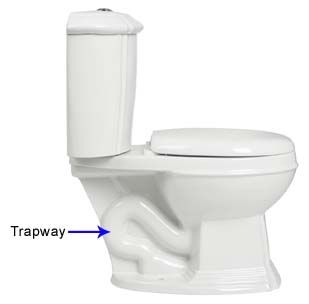 Typically, siphonic toilets will have a long and narrow reverse ‘P’ or ‘S’ shape trapway. With one end as the inlet in the bowl, and the other connected to the drain pipe underneath the bowl.
Typically, siphonic toilets will have a long and narrow reverse ‘P’ or ‘S’ shape trapway. With one end as the inlet in the bowl, and the other connected to the drain pipe underneath the bowl.
This trapway design is intentionally meant to create a siphon. And that’s exactly how a siphonic toilet will work.
How Does A Toilet Siphon Works?
A flush begins with pulling the lever or pushing a flush button. Then the flush valve opens letting the tank water flows through into the bowl.
In the case of a siphonic toilet, typically you will see the water in the bowl rises and then subside rapidly into the bowl outlet. What happens is, the water is flowing out faster from the tank than it tries to exit the bowl. This is usually due to a larger flush valve diameter than the trapway.
As water exits through the trapway, it displaces the air inside to form a vacuum. Then when it flows over the kink (or weir) in the trapway, that’s when the siphon begins. You can tell from the water in the bowl that a siphon action has started when it stops rising and begin to subside rapidly.
The siphon, at its optimum state, is so strong, heavy solid wastes get sucked out with the water. You may see a swirl with some siphonic toilets, but the working principle is the same.
Towards the end of the flush, you can hear a gurgling sound, that’s when the vacuum is broken and stop the siphon. The bowl is filled with the remnant water and the refill in the tank begins. All ready for the next flush.
That’s basically how a siphonic toilet works.
New Siphonic Toilets With Greater Focus On Details
As you can see, the siphon is central to a siphonic toilet. In the past, before the US Energy Policy Act of 1992 (EPAct) kicks in, siphonic toilets use 3.5 gallons of water per flush.
The act regulates water volume for toilet flushing to a maximum of 1.6 gpf (gallon per flush). That’s more than 50% of saving on water for toilet flushing. On a national level, that’s a lot of water we are talking about.
So how does a drastic reduction of flush volume can improve the efficiency of a flush toilet?
With only 1.6 gallons of water to play with, you just have to do things differently. From the valve opening right down to the trapway design, everything has to change and improve.
Rethinking Toilet Design
There’s a whole lot of focus on details with the small water volume in mind. So the coordination of the various toilet parts has to be precise. In particular, the flushing and bowl design needs to work on to get more done with much less water.
And competition for market shares is also key drivers for greater innovation. The result is a highly efficient flush toilet we see today. This is evident with the host of fancy names given to toilet flushing systems. Like Vormax, Double Cyclone, G-Max, AquaPiston…etc.
Even the bowl and trapway are not spared either. The new toilets will have bowls and trapways fully glazed for smoother water flow and to prevent stains. And you may have heard of EverClean Surface or the CeFIONtect Finish. They are proprietary glazes developed by American Standard and TOTO respectively and deemed as better than the conventional glaze.
So, if you are still using the old 3.5 gpf toilet, this is the time for a change. And it won’t cost you an arm or a leg to make that switch. You get a better performing toilet that saves water and money.
Characteristics of Siphonic Toilets
It’s easy to identify a siphonic flush toilet. From the appearance, the S-shape trapway is clearly visible. But if the toilet is of a skirted design or having its trapway concealed, you can look at the water level in the bowl. A siphonic toilet typically has a water spot high above the bowl outlet and measure about 7″ x 8″ or bigger in surface area.
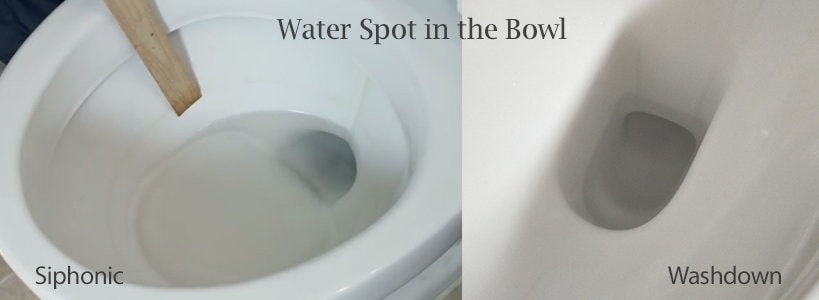
This water in the bowl is to seal off the noxious gases in the sewer pipe and also to minimize stubborn waste from sticking on the bowl surface. Also, you will experience less odor emitted by the waste during evacuation as they are submerged in the water.
The glazed surface of the bowl also plays a big part in ensuring nothing stays in the bowl during a flush.
However, siphonic toilets are prone to clog because of its narrow and winding trapway. So, having a plunger next to one is a common sight in most American bathrooms. Despite that, they are the power flush toilets that are preferred by Americans.
Another drawback of siphonic toilets is, the bowl base is generally longer to accommodate the trapway. If you are a little short of legroom, you will be limited to those compact size toilets. But you can still find some siphonic models out there that are as short as 24 inches front to back.
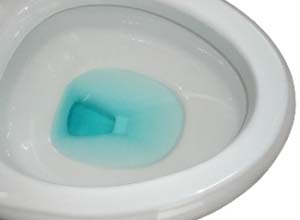
Features
- Large water surface area
- High water level in bowl
- Long and narrow S-shape trapway
- Longer bowl base
Advantages
- Cleaner bowl with lower probability of skid marks
- Powerful and quieter flush
- Save water
- Almost odorless
Disadvantages
- Prone to clog due to long and narrow trapway
- Bigger in size (longer bowl base to accommodate the long trapway)

What Are Washdown Toilets?
Washdown toilets or European toilets are seldom seen in American homes. You will understand why as you read further.
The way it works is simple. It uses the weight and gravitational flow of water from the tank to flush-out waste from the toilet bowl. It can’t create the siphon action.
In other words, wastes are pushed out by the sheer pressure of water gushing out from the tank. Its short and wide trapway allows for waste and water to exit the bowl easily.
The trapway diameter of a washdown toilet is easily twice the size of the siphonic model. Normally around 4 inches wide and much shorter. And due to its super-short trapway (see image above), the weir is at a lower level. Therefore, the water level can never be above the outlet rim in the bowl. As a result, you get a small water surface area.
The washdown toilets are relatively clog-free because of its short and wide trapway.
And the main reason why the washdown toilet can’t have a large water volume in the bowl is that the content needs to be light to get push over easily. So, if you have a heavy session some of the water will be displaced, leaving a lean mass of waste to be flushed away by the rushing water from the tank.
Most of the washdown toilets come with a push-button dual flushing system. It has 2 flushing capacity, a full flush and a half or partial flush. The half flush is usually 1.0 gpf or lower and useful when you only need to clear liquid waste. The full flush is, of course, meant for removing solid waste.
Here’s Why Americans Are Not Ready For The Washdown
Perhaps we never will.
Washdown toilets may have the advantage of being clog-free, they are not great at bowl cleansing. And bowl streaking is a problem because of the small water spot, which causes skid marks to form easily.
Odor is also a problem with the washdown toilet especially on heavy load. As the wastes are not fully submerged in water, odor can instantly fill the air. So your bathroom or restroom needs to be well ventilated and having an exhaust fan is a good way to keep the toilet fresh.
Another shortcoming is the need to flush twice on a heavy session. Not that it can’t clear solid waste efficiently, it’s the waste smears on the bowl surface that are the problem. Often you will need to pull a second or third flush to get a clean bowl, hopefully. Having a brush handy is almost not an option.
But having said that, some reputable European brands have the bowl surface glazed with a layer of hydrophilic coat. That effectively solved much of the stubborn waste smear issue.
And most of all, Americans hate a noisy flush. Gushing water can never be quiet. It’s embarrassing to hear toilet flushes with guests in the house, especially at the dining table.
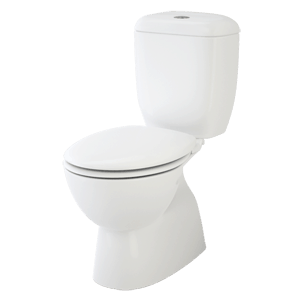
Characteristics of Washdown Toilets
They are shorter in length (front to back) obviously. The modern washdown toilet uses push-button flush instead of a trip lever, and they are usually dual flush. But that’s not necessarily always the case. There are models that are still using the trip lever, even for dual flush toilets.
Click here for Short Siphonic Toilet Options
The trapway is designed to be wide and short so waste can easily get push over the weir and straight into the drain pipe. And because of this, the water level is just at the brim of the bowl outlet. Hence, the water surface area is just as big as the bowl outlet (typically about 4″ x 5″).
Features
- Short body length
- Short and wide trapway
- Small water surface area
- Skirted design (There’s no trapway to concealed)
Advantages
- Saves water (dual flush)
- Efficient waste removal
- Clog free
- Compact in size (shorter bowl base)
- Lower cost
Disadvantages
- Odor
- Loud and noisy flush
- Small water surface area – Bowl streaking that leads to unsightly skidmarks
- Often need to flush more than once for heavier load or to remove sticky waste
Regardless of toilet types and design varieties, these are the 2 toilet flushing systems the world is using. Both have their merits and flaws, you will need to weight them out and decide which one can best serve your needs.
End of the day, it all voice down to personal preference. Especially for a toilet, you can’t get more personal than that.




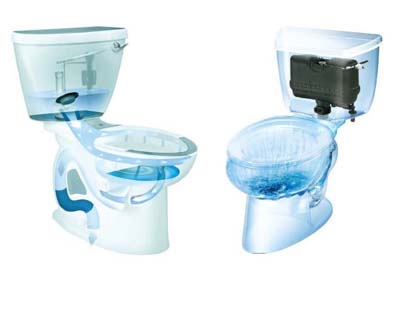

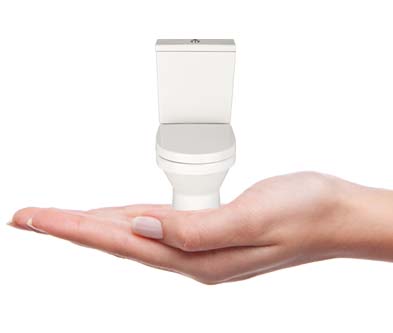
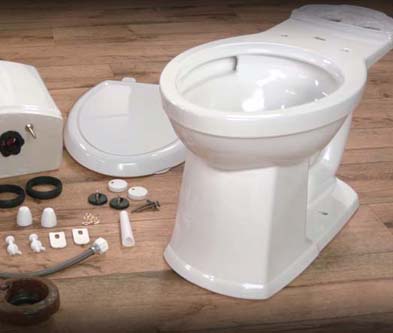
Washdown trapways are not 4″ and are not double what siphonic trapway diameters are. I have seen 1.6 gpf siphonic trapways that are 2.12″ diameter, and washdown trapways that are only 2.5″ diameter.
I guess Kohler is a USA brand, so it must be a siphonic flushing toilet type? but they flush very well. So flushing performance may not be determined by whether it is siphonic or washdown only?
Hi.
Kohler is everywhere. For USA, yes they are all siphonic toilets but not sure about other countries, particularly in Europe (most likely to be washdown).
Whether it is siphonic or washdown, each has its pros and cons. It actually depends on what you are used to. So, you are probably right about the flushing performance of both.
Martin
I’m looking for toilets that have the water tank in the wall and the toilet itself is mounted to the wall. Leaving a clear floor area under the bowl. They would be far easier to clean around. The washdown sounds the way I would like to go so might have to import.
I have heard of toilets that have an exhaust fan that operates within the bowl which if they are available would solve the odor problem.
Hi James.
What you are looking for is called a Wall-Hung toilet. If you need a fan within the bowl, you can opt for a Smart Wall Hung toilet, or you can swap the soft-close seat for a smart bidet seat. Both options will have the deodorizer function and can cost you anything between $1000 to $3500 depending on the brands/models you are buying. And that does not include installation cost which is another $2,000 (estimate) if you are converting from a floor mount to a wall-hung toilet.
There are plenty of options for wall hung toilet here in the United States and they are all washdown flush. No need to specially import them. You may want to take a look at Kohler, Toto, Swiss Madison and American Standard.
I can’t believe getting so much knowledge about toilets by reading this article and comments lol.. Thanks for all the info! Just bought a new small house for my mum and decided to change all the toilets as the one installed from developer typically just cheap ones.. Browsing lots of brands and specs making me confused hahaa.. still can not decide whether to choose washdown or siphonic tho
Hi Dheeny, if you are in the US you can’t go wrong with a siphonic crapper.
Hi Dheeny
To be frank if you do very large diameter poos then a washdown toilet will generally be less likely to block, otherwise siphonic is always better smell & bowl cleanliness wise.
Cheers Martin
Oh also, what’s with the high water usage in either Europe or the US? If you want to save water flushing a toilet, you really only need to flush once a day or after a BM. Why people can’t stand their own urine, I don’t know. On a water saver toilet, I only use a gallon a day that way!
It’s like clothing, if it’s not cold outside, or you need to cover over to avoid sunburn, why wear them? Are people so ashamed of their so-called “private parts” that we somehow need laws that say you need to cover them up? It makes no sense.
@Fixit Mann
Interesting perspective. But I doubt that will happen in our lifetime. Mindset is what you have to deal with first. 😉
Well, we could entirely rid ourselves of the flush toilet and not worry about how much water is used. How about composting toilets, incinerator toilets, and the good old standby, the outhouse? I mean, I understand most places you can’t install an outhouse in your backyard, as you may live in an apartment 3 floors up, but still, something like the Sun-Mar would be feasible.
As to these tiny, 2 inch trap, 1 gallon per flush toilets? Useless. You’re always having to plunge or snake them out, and they won’t even flush a small potato, which is what I always look for in a toilet. That plus the ability to flush at least 4 gallons of water without overflowing, and preferably 4 bolts holding it to the floor. In other words, any toilet made in the last 50 years is no good to me.
Hi. A perspective on this subject is as below (from the UK):-
Siphonic toilets are far superior to washdown for 4 reasons,
no. 1 As has been already mentioned a siphonic bowl can be designed to have a large pool of water in the `sump’, this greatly reduces the smell since most or all of the poo is immediately submerged;
no. 2 The large pool of water reduces `skid marks’ on the china;
no. 3 The water is very clean after a flush since all the dirty water is removed during a flush (not just diluted as for washdown);
no. 4 All waste is positively removed including stubborn `floaters’ & floating loo paper (especially that old fashioned `tracing paper’ type). Sorry to call a spade a shovel.
UK single trap siphonics, popular in the 1950s, were truly siphonic in that the trapway in the loo body was smaller than in washdown toilets so that siphonic action was set up when a lot of water was suddenly introduced into the bowl, however they were prone to blockage due to the restricted trapway.
UK double trap siphonics had no such disadvantage (of a small trapway). They were clever in that they produced the illusion of siphonic operation (actually a constant stream of water flowing out of the bowl) without being truly siphonic imo.
As the name implies they had 2 water traps. There was a pressure reducing fitment (siphonic `bomb’ so named due to the shape) in the outlet of the cistern siphon that worked by the venturi effect of the water rushing out of the tank to reduce the pressure between the 2 traps.
This resulted in the water level in the pan reducing until virtually empty (sometimes with a gurgle as the 1st trap’s seal is broken) when flushed and, once the rim jets were established the `flow through’ effect was evident. Of course the water in the 2nd trap would have been pulled up into the toilet body as well but I don’t believe they ever met and, as previously mentioned the 1st trap seal is constantly in danger of being broken during flushing.
N.B. The siphonic `bomb’ has a rubber doughnut seal that after about 20 + years will need replacing to maintain good operation.
These work on a 2 imperial gallon (UK) flush although they were available with a short flush (approx. 1 imp. gallon for a pee).
When the EU bought in reduced water consumption rules there was apparently no big attempt to re-design the toilets to work on a reduced flush and washdown became the norm in the UK, unfortunately. It’s crazy imo since washdown toilets often require more than one flush (which was one reason why siphonics were introduced in the first place).
https://www.google.co.uk/search?q=2+trap+siphonic+toilet&tbm=isch&source=iu&ictx=1&fir=8Zrni3n82Q634M%3A%2CeIZnsNOa9DA5nM%2C_&vet=1&usg=AI4_-kSLe18cDyXRnRzbszbfwmtpQuO6NQ&sa=X&ved=2ahUKEwi2sLSeq_3kAhUpQxUIHecbAtUQ9QEwFnoECAQQCQ#imgrc=8Zrni3n82Q634M:
https://www.youtube.com/watch?v=FB9ADms3Cf0
USA siphonic toilets are always single trap (but I understand that the trapway is not as narrow as for the 1950s UK single trap loo). They usually use a submerged water jet in the loo body to rapidly set up the siphonic action and remove the water from the bowl and work very well.
@Martin thanks for your valuable insight on the siphonic toilet.
Here’s another Youtube video on the dual trap toilet ► https://www.youtube.com/watch?v=vmUJnky052A
You can see how a dual trap looks like, at around 2:36 in the video. And here’s a modern dual trap toilet that consumes only 0.8 GPF ► https://toiletfound.com/niagara-stealth-toilet/
Thanks @Bud. Loved the old Shanks & the Niagara Stealth looks very clever.
I’m glad that the US have achieved such low water consumption while retaining the advantages of siphonic action..
Unfortunately, this is not the case. Despite all the regulations, much more water is still used in the USA than in Germany. Especially for toilet flushing, countries with washdown flushing use considerably less water than countries with symphonic flushing. I have already pointed this out in this comment: https://toiletfound.com/siphonic-vs-washdown-toilet/#comment-1043
“In Germany, a person consumed an average of 121 liters of water per day in 2013 (with a downward trend), of which about 27 percent or 33 liters is used for toilet flushing.
In the US, on the other hand, a person consumes an average of 327 liters (or 86.5 gallons) of water per day, of which about 24 percent or 78 liters is used for the toilet flush. In 2015, according to preliminary data, there are still 325 liters (or 86 gallons) consumed per person per day (domestic self and puplic-supplied per capita per day use in the US).”
Hi Andy, that might be because Americans along with our public bathrooms, our restaurants, etc, etc, have not “upgraded” their toilets to the modern toilets. It seems in Europe, even in the older homes, the restaurants, the museums, and other public bathrooms, the folks have all upgraded them. Not sure why, except that it is hard to get an American to agree with a government mandate, especially when they have to pay to comply with it. Maybe in Europe they did have government mandates, and they agreed it was good for all, even if they did need to shell out some money. Maybe those who needed monetary help were given it, too, which is also much harder to agree on in the US. The US is a challenge to govern as one, as we all need to agree on what we all agree to do. States can have an easier time of it, because they govern much smaller populations. Europe is a more advanced society than the US, although, of course, the US is a great country, too, even if it is quite young, still!
The main disadvantage of the UK 2 trap siphonic toilet is, if e.g. a child throws a foreign object into the toilet and it get stuck in the toilet body (perhaps floating above the 2nd trap) it is almost impossible to clear it since there is such a tortuous route through the toilet and there is no inspection cover to expose the tube between the 2 water traps.
Also they were more expensive than washdown toilets.
Yup. And augering the dual trap is no fun at all….lol
@Bud Yes forget using an Auger. I did manage to get a flexible fibre optic camera fed in through the hole in the toilet bowl that the bottom of the Aspirator (`siphonic bomb’) sits on (cistern removed) but still couldn’t see what was causing the toilet to misbehave.
In the end out of desperation I carefully poured premixed Caustic Soda into said hole (very slowly so as to not crack the toilet due to the heat). I left it for a couple of hours (instead of the recommended 20 – 30 minutes) and then thoroughly rinsed and re-assembled the toilet. STILL it wouldn’t work but during the week it did clear (my parents were using it for pee) so presumably the caustic soda damaged whatever was in there and it eventually went down the drain.
The situation was made far worse due to the habit in the UK of cementing the toilet down to the floor so it is not possible to remove it to the garden and jet it out or get a hand up the 2nd trap !!
@Martin181
“cementing the toilet down to the floor” … even now? As in the drain hole is cemented to the drain pipe? Someone ought to promote flanges and wax rings to your country. Then you can swap toilet anytime you want.
@Bud The toilet was installed in the early 1970s, I hope that cementing is now a thing of the past (it has got a modern plastic drain connection). But yes in the 50s toilets in the UK were routinely cemented to a concrete floor and to the clay or iron drain pipe. This occasionally led to the toilet cracking of course since it is then held so rigidly.
Hello Martin,
Wow what a fantastic description. We had 3 Twyfords Double Syphonic WC’s fitted here in the UK 1980. They were and are wonderful, no bells and whistles, just well made and efficient. Unfortunately one of them has developed a hairline crack in the base and is leaking. The other two apart from replacing the bombs every 15 years or so are fine. So I am now faced with the awful task of choosing a new WC a real minefield. So much blurb and most showrooms want to design a bathroom for you. I just want to replace the WC with a similar WC bearing in mind that double siphonic are no longer made. What would you recommend which is good quality, efficient at getting rid of solid waste without blocking and doesnt go wrong, well they managed it with our Twyfords. Because most new loos are available in any colour as long as they are white I initially looked into trying to source discontinued Twyfords in Avocado but prices are ridiculous and one can never be sure that they have no issues so reluctantly think buying new is best in long run.
Anyway many thanks and all the best,
Frank
Hi Frank.
If you are thinking of getting a new toilet, which 99.99% will be a washdown model, the plumbing may have to be re-adapted. Frankly, I don’t know much about UK toilets as in brands and cost… but the fundamentals remain the same.
I’d look at the flush valve opening diameter. A 3-inch (76mm) or bigger valve opening will give you a good flushing power which is important for a washdown toilet. Other than that, you can go for a rimless bowl (recommended) which offers better bowl rinsing and easier to keep clean. Also, consider the type of bowl glazes. If you want a highly efficient flush, go for the nano glazes but they can cost significantly more. Brands like Toto, Burlington, Britton, and Villeroy & Boch offer nano glazes for some of their best-selling models.
Finally, I’ll ask the vendor if a Geberit flush valve can be fitted with the toilet. This is just my personal preference because I’ve used them before and they are super durable 🙂
Hope that helps and good luck.
Martin
Hi Frank.
Apologies for the delay in replying.
I despair !! You could try places like Brokenbog in Southern England or even ebay for second hand double trap siphonic toilets.
A friend of mine recommends Grohe …… although not siphonic :-
https://www.grohe.co.uk/en_gb/euro-ceramic-wall-hung-wc-with-pureguard-3932800H.html
Luckily for me purely by chance I moved into an old house with a very rare Alfred Johnson single trap siphonic WC.
Wish you luck.
All the best,
Martin
As I mentioned earlier, due to the low water consumption, our sewers clog and dull much more often than before. Many sewage pipes date back to the 70s or 80s, they are initially designed for a much larger amount of wastewater. In addition, many wastewater treatment plants are underutilized, which significantly reduces the effectiveness and increases the maintenance costs. This leads to rising water prices, the less water is consumed, the higher the price of one cubic meter of fresh water and sewage gets. This is due to the fixed costs for water production and wastewater treatment.
The biggest factor for the low water consumption are the high costs for water and for wastewater (wastewater is more expensive in Germany than fresh water). In Cologne, we pay about 3.33 € (1.64 € fresh water and 1.68 € wastewater) for one cubic meter of water. In Berlin, however, it is € 5.12 (€ 2.24 fresh water and € 2.88 wastewater). In contrast, you pay in Detroit about 1.57 € for a cubic meter of water and sewage (plus the basic costs).
Another reason is the development of water-saving washing machines and dishwashers. In the 1980s, these devices were still among the largest consumers of water, currently both devices consume only about 18% of total water consumption. Here there are actually legal regulations, so current devices may only have a certain maximum water and electricity consumption, so that they may be sold in Europe.
@Andy
Well I can see the water saving part on other appliances but toilet. There’s a minimum for toilet. Besides flushing water is needed to carry the waste to the septic tank as well. You can’t keep reducing the flush volume. Unless new sewer system come into play with better waste disposal efficiency, I can’t imagine my waste is stuck somewhere along the drain pipe waiting for the next flush to hopefully push it further and nearer the septic tank. lol
As a kiwi with US relatives I visit a lot and hate US bumsplasher toilets. The ones in public lavs (dont get me started on the lame euphemism “bathroom” – It’a the toilet/dunny/bog/lav. There is no f..king bath in there) are worse as the water trap is at testicle level. The number of these hideous contraptions I have seen blocked defies counting. Just another bit of yank Exceptionalist nonsense.
Ha, I’ve always wondered why people call it a bathroom when it doesn’t even have a bath in it. Or even a shower for that matter. It’s just the toilet for me.
“Bathroom” is just Yanks being prudes :-).
Actually, dudes, ROFLOL, it is a “restroom” in public, as you notice the plaques on the “Restroom” door in public spaces.
So, no, actually, the ‘bathroom” is for bathing, not for resting. Unlike as you will find in many buildings’ restrooms, an actual space to “rest”. However, I have never been in the men’s restrooms in such places where they have, some quite lovely actually, rest areas for the ladies to rest ROFLOL.
It’s not the toilet, Andrew, it’s you. Your turds are too big and your balls are too saggy.
As for your “bathroom” persnicketiness – the toilet is the fixture, not the room, a dunny is a cellar, a bog is a swamp, and a lav doesn’t always have a toilet in it. Oh, and I may as well also mention that a kiwi is a bird and a fruit, but not a person. You’re better off with the classic observation that Americans park on driveways and drive on parkways.
Hi Andrew
I used to find it amusing that Americans call the WC the bathroom until I realised that at least two of our words (UK) are also too precious to take the subject head on ……..
Lavatory. This also comes from the Latin word “lavare”, although it follows a different path through the Medieval Latin word ‘lavatorium’, which means ‘washbasin’. It was first used around the 14th century.
How the Toilet Got Its Name. … The Middle French word ‘toile’ (“cloth”) had a diminutive form: ‘toilette’, or “small piece of cloth.” This word became ‘toilet’ in English, and referred to a cloth put over the shoulders while dressing the hair or shaving.
All the best,
Martin
Hi Martin! Yes, the WC is for Water Closet! And maybe we know this in my family because they are the initials of my male relatives first and middle names! As was BM – bowel movement – my sis’ initials of her first name and last name. So these merited quite a talking about when we were tiny kids!
I have made the exact opposite experience with never 1.6 GPF symphonic Toilets in the US while I was on holiday at the east coast. Many of the new 1.6 GPF toilets were not able to wash out the entire contents with a single flush, sometimes it needed more than two flushes. Some of these toilets even had problems with non solid waste or a single sheet of toilet paper. Only toilets with high tank or flushometer were more reliable. In contrast, my Keramag Allia Paris toilet with 6 liters or 1.6 GPF flushes even larger loads down. It is very rare that I have to rinse several times. Skid Marks are indeed a problem, but they can also be avoided. Newer toilets here in Europe have a special surface coating which makes it easy to remove soiling with a single flush.
Hi Andy. Thanks for sharing your experience.
I supposed your Keramag Allia Paris is a wall hung toilet with a 4 inch (100mm) trap/drain pipe? That’s awesome. 🙂
I’ve been to europe a couple times and never understood why it seemed like their toilets used huge amounts of water. Now i know why. But this article never mentions the volume of water differences for each design? European toilets waste a lot of water and those types of toilets would never work in drought prone areas.
Hi E.
Regardless of design, the maximum water use for toilet flushing is 1.6 GPF in the United States. Europe will have a different rule on water usage for toilet flushing.
“In 1992, the United States Congress passed the Energy Policy Act of 1992, which mandated that beginning in 1994 common flush toilets use only 1.6 US gallons (6.1 L).” Reference – https://en.wikipedia.org/wiki/Flush_toilet#US_standards_for_new_toilets
So all toilets, including the washdowns, that are sold in the US will have to meet the maximum 1.6 GPF. However, in states like California, Colorado, Georgia and Texas only 1.28 GPF max. are allowed to be sold.
Hope that answers your question.
Cheers
Martin
It is not correct that German toilets consume more water than American toilets. In fact, newer German toilets uses only 6 liters (1,6 GPF) of water. Most cisterns also have a button for a 3-liter (0,8 GPF) economy purge, which is sufficient for smaller dumps due to the low water level in the bowl. In Germany, only cisterns are available which have a maximum capacity of 9 liters, but the default manufacturer setting is 6 liters. Some newer rimless-free toilets only work with 6 liters, with 9 liters they will overflow. It was quite a while ago when there were still cisterns to buy with 12 liters. There was an 12 liter cistern in my actual home (Build 1980), but i replaced it with an Vigour cistern (HE-CLIVSP).
It is even an advantage of the European wash-down toilets that they flush very well even with little amount of water. In contrast, some of the older US toilets had to be completely redeveloped with the introduction of the Energy Police Act. Some manufacturers needed years to adapt the toilets to the new volume of water. Until then, clogged toilets and incomplete flushing were common.
Moreover, there is no legal regulation in Germany how much water the toilet is allowed to use. We do not need something like that, because water consumption is very low even without legal regulation. Due to the sharp decline in water consumption in Germany in recent decades, we have quite different problems to solve.
P.S.: Yes, my Allia Paris WC has an 4-inch (100mm) trap/drain pipe, it is even impossible to clog it during normal use, maybe if you try to wash down a turkey ;).
Thanks Andy.
In fact, 4.85 liters (1.28 gal) and 3.8 liters (1.0 gal) are becoming more and more common in the US right now. All the top manufacturers like American Standard, TOTO, and Kohler have rolled out the 3.8 liters recently, and they are siphonic models predominantly.
So that begs the question, Can the washdown work well with such capacity? It would be interesting to see that on a washdown, and I believe there have to be some changes to the design to go low (3.8 liters) on the flush volume. Definitely hope to see that happened. 🙂
Martin
As I wrote above, most of our toilets have a savings flush of about 3.0 liters, and this works quite well. I rarely use the full 6 liters of my water tank, I break the flushing usually long before. The only reason why I have not less water in the tank is the water pressure, the higher the water level in the tank, the better a wash-down toilet flushes. Incidentally, this is also a very simple way to save water at wash-down toilets, higher water level results in better flushing performance. Most wash-down toilets have a main jet that shoots directly into the opening. You should see a wash-down toilet with a high water tank or a flushometer. 😉
Water saving is much more complicated with symphonic toilets, the price and the susceptibility of the toilets to blockages and defects increases. If a symphonic toilet is clogged, it is not always easy to get rid of it again. In wash-down toilets, it is almost always solved by bare hand (using a glove, of course).
As for the allegedly higher water consumption European or German toilets:
In Germany, a person consumed an average of 121 liters of water per day in 2013 (with a downward trend), of which about 27 percent or 33 liters is used for toilet flushing.
Source: https://www.umweltbundesamt.de/daten/private-haushalte-konsum/wohnen/wassernutzung-privater-haushalte
In the US, on the other hand, a person consumes an average of 327 liters (or 86.5 gallons) of water per day, of which about 24 percent or 78 liters is used for the toilet flush. In 2015, according to preliminary data, there are still 325 liters (or 86 gallons) consumed per person per day (domestic self and puplic-supplied per capita per day use in the US).
Source: https://water.usgs.gov/watuse/data/2010/index.html
Despite all efforts and legal regulations, American symphonic toilets still consume many times more than German wash-down toilets. And this, although there is no legal regulation in Germany how much water a toilet may consume. In recent decades, our water consumption has fallen so much that we now have completely different problems, so our wastewater treatment plants are underutilized and our sewage pipes clog. The fact that some European countries have a higher water consumption than Germany is not due to the toilets (they are the same type everywhere in Europe), it has other reasons (for example garden irrigation and swimming pools in the southern countries).
A problem in the US is simply that many people flushes the newer water-saving toilets several times or directly install a larger water tank. I was allowed to experience this myself during my trip around the west coast. Due to the sometimes poor flushing performance of the newer toilets, there is indeed a demand in the US for old “vintage” toilets that have a more powerful flush. Therefore, I do not think that the toilets in the US reach the low water consumption of German or European toilets, even in the long term. Of course, there are some bad examples of wash-down toilets, and not every combination of toilet and cistern works well, but this is the same problem with symphonic toilets (or even worse).
There are certainly pros and cons between the modern symphonic and wash-down toilets, and of course there are some bad examples on both sides. but for sure, wash-down toilets will usually not consume more water than symphonic toilets. Everything else is, as the current president likes to say, fake news. It’s the same as the myth that there are only shelf toilets in Germany (The one, where the waste is collected on a pedestal for better inspection afterwards). I have not seen such a toilet for years, and I’m very pleased about that.
The only clear advantages of symphonic toilets in my eyes is the less an odor, water splashes and skid marks, due to the higher water level. But skid marks and water splashes when using wash-down toilets can be prevented with a bit of practice, so there is no need to flush double. When it comes to noise, I see a draw. There are some wash-down toilets that make virtually no noise. In contrast, some cheaper symphonic toilets are extremely loud especially at the end of the flushing.
BTW: I find it astounding that in a country where every state interference in private life is denied, a law for banning toilets with too much water is passed without protest. Toilets are probably no guns and they lack the lobby. 😉
@Andy.
“In recent decades, our water consumption has fallen so much that we now have completely different problems, so our wastewater treatment plants are underutilized and our sewage pipes clog.”
Wow! how is that even possible? What causes the fall?
Martin
Andy! What a great link you provided! But how from this link do you see how much water Americans are using to flush their toilets vs how much water Germans are using to flush their toilets? Can you point out where you find that computation? From your link, this includes all water used in the US. Among other calculations, this includes the water used for the land mass that is used to grow food in the US, too.
Also, a “law for banning toilets with too much water” does not exist; so yes, your instinct about that is correct, actually. This law is for only newly manufactured toilets. There are plenty of old toilets all over the USA! And there are probably a lot of folks in the US who know nothing and/pr next to nothing about “low flush” toilets! Unless they’re upgrading their fixtures, or buying an old house that they find out upon sale/buy must have at minimum one low flush toilet in it! Evidently, there are a lot of visitors to the US who are using these old toilets and cannot imagine the difficulty they are having flushing their waste! Yep, it’s those dang old things. I’ve got one I have to replace myself, which is why I’m on here! To confess, I am one of those folks who had “vaguely” heard about those low flush toilets. Yep, I’ve waited and waited, so here I go. Thanks for all the great info!
lets not forget that due to the fact that you have to use your toilet brush practically every time something “solid” landed in your bowl, you have to rinse at least a second time. So you end up with wasting using at least 6+3 or even 6+6 liters of water.
And this whole act of brushing this mess clean and then getting the brush clean is disgusting. I would love to safe water somewhere else instead on this not so unimportant act.
Well, we learn to aim well early. 😉 Apart from that, usually a sheet of toilet paper in the right place is doing the business. It is quite rare that I have to rinse a second time. On my holiday in the US however, I often had the problem that I had to rinse a second or even third time, because something escaped the siphon. And I do not want to think about the unpleasant experience when I clogged a toilet with my host family. Apart from that I like the Flushometer in the US, unfortunately they are only available in public toilets. High tank toilets are also quite rare, both in Germany and in the USA. By the way, I do not like it when my testicles get wet. I assure you, This will never happen to you in Germany.
Thanks for the input Andy. A siphonic toilet is a lot more complicated in design than the washdown. It takes some precision on the flushing process from the size of the trapway to the water volume in the tank. If it clogs too often, it simply means the overall design wasn’t that great. This argument will go on between Americans and Europeans until we have a more universal design that really addresses those pet peeves with either toilets.